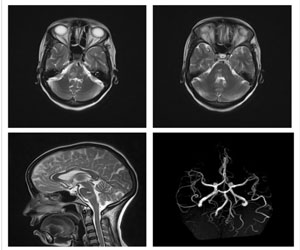- Home
- Editorial
- News
- Practice Guidelines
- Anesthesiology Guidelines
- Cancer Guidelines
- Cardiac Sciences Guidelines
- Critical Care Guidelines
- Dentistry Guidelines
- Dermatology Guidelines
- Diabetes and Endo Guidelines
- Diagnostics Guidelines
- ENT Guidelines
- Featured Practice Guidelines
- Gastroenterology Guidelines
- Geriatrics Guidelines
- Medicine Guidelines
- Nephrology Guidelines
- Neurosciences Guidelines
- Obs and Gynae Guidelines
- Ophthalmology Guidelines
- Orthopaedics Guidelines
- Paediatrics Guidelines
- Psychiatry Guidelines
- Pulmonology Guidelines
- Radiology Guidelines
- Surgery Guidelines
- Urology Guidelines
Case of Twenty-and-a-half syndrome: a report

Dr Mukesh Dube and Colleagues at the Department of Neurology, Sri Aurobindo Medical College & P.G. Institute, 4th Floor, Sanwer Road, Indore, MP, India have reported for the first time a case of Twenty and a half syndrome that has appeared in the Journal of Medical Case Reports.
The one-and-a-half syndrome is a syndrome characterized by horizontal movement disorders of the eyeballs, which was first reported and named by Fisher in 1967. On the basis of the one-and-a-half syndrome, there are a series of related rare syndromes called the one-and-a-half syndrome spectrum disorders. Twenty-and-a-half syndrome is characterized by one-and-a-half syndrome with bilateral seventh and right fifth nerve palsy (1.5 + 7 + 7 + 5 = 20.5) in a patient with ischemic stroke.
A 45-year-old Asian Hindu woman presented with vomiting and imbalance of 1 day’s duration. She had left-sided ataxic hemiparesis with one-and-a-half syndrome with bilateral seventh and right fifth nerve palsy. Magnetic resonance imaging of her brain revealed acute non-hemorrhagic infarct in the right posterolateral aspect of pons and medulla, with normal brain vessels angiography. We described her disorder as the twenty-and-a-half syndrome. She was put on antiplatelet therapy.
Twenty-and-a-half syndrome is reported for the first time. It is due to posterior circulation stroke; in our case, it was due to lacunar infarcts in the pons and medulla, manifesting as one-and-a-half syndrome with bilateral seventh and right fifth nerve palsy.
There are many syndromes that describe disorders affecting eye movements and cranial nerves, such as one-and-a-half syndrome, eight-and-a-half syndrome, fifteen-and-a-half syndrome, sixteen-and-a-half syndrome, and twenty-four-and-a-half syndrome. In 1967, C. Miller Fisher reported horizontal gaze palsy to one side along with ipsilateral internuclear ophthalmoplegia (INO) resulting in loss of all horizontal movements in the ipsilateral eye, except abduction of the contralateral eye, with the lesion within the ipsilateral pontine tegmentum, naming it numerically as one-and-a-half syndrome. Anatomically, involvement of a combination of medial longitudinal fasciculus (MLF) plus abducens nerve nucleus or involvement of MLF plus paramedian pontine reticular formation (PPRF) can cause one-and-a-half syndrome. The involvement of a facial nerve with one-and-a-half syndrome was termed eight-and-a-half syndrome by Eggen-Berger who first reported three such cases.
In continuation of this concept, the authors have reported a new neuro-ophthalmological syndrome, twenty-and-a-half syndrome, comprising one-and-a-half syndrome with bilateral seventh and right fifth nerve palsy, which has never been described before in the medical literature; furthermore, this novel syndrome gives an insight into the brainstem and its connections, in particular, the dorsolateral pons and medulla.
For more details click on the link: https://doi.org/10.1186/s13256-019-1980-4

Disclaimer: This site is primarily intended for healthcare professionals. Any content/information on this website does not replace the advice of medical and/or health professionals and should not be construed as medical/diagnostic advice/endorsement or prescription. Use of this site is subject to our terms of use, privacy policy, advertisement policy. © 2020 Minerva Medical Treatment Pvt Ltd